Foresights and ideas that expand minds and inspire a change of heart.
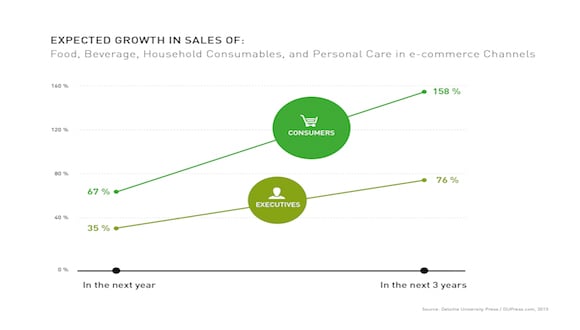

In january 2015 I was invited to the Produce Marketing Association Summit in Dallas, Texas which they organize each year in association with Cornell University.
I was invited to be the futurist in residence to talk about three major digital trends (or three waves of change as my keynote is entitled) that will be impacting the Produce Marketing Industry or the produce and food industry as a totality looking towards the future with a 2020 horizon.
The trends that I adressed during my keynote at PMA:s event was:
Let me kind of attack them here in this blog in a step by step fashion:
Firstly I want to discuss this idea of the informed consumer vs the status quo. We are living in a age where the meal sizes in the UK and in the US have nearly quadrupled in size since the 1950s and people are spending more time in front of computers and not doing as much manual work and as a result of course people are becoming larger.
This high level of food consumption is causing the increase in diabetes in the Western World but also in the developing world.
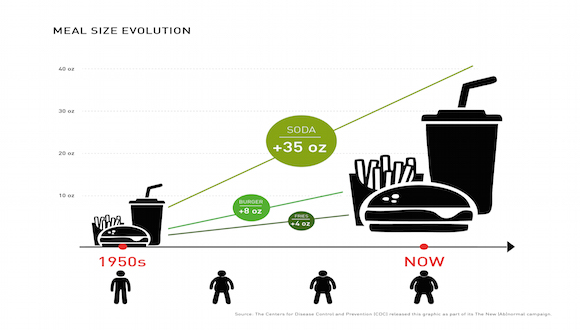
This of course is both a result of our diets changing, our access to proteins, the rise of the fast food industry as well as confusing labeling. We are probably overwhelmed with this kind of information. The consumers are in a situation where they are losing the ability to make sense of what actually is in the food that they are about to consume or they never cook anything fresh at home and as a result people are making uninformed consumption decisions about what they put into their mouths and bellies.
The likes of Nike+, the Jawbone app, the Nike+ FuelBand and Fitbit are helping people making smarter decisions about their health and what they consume and this is true also of apps such as Fooducate or even the recent launch of the Vessyl that integrates with your mobile device to tell you exactly what you are about to drink. The Vessyl is literally a vessyl where you pour your drinks into and it can measure things like sugar levels, caffeine levels and other preservatives or colorings etc. that you are about to put into your belly. As a result of this consumers are able to make new decisions about their consumption and what they eat and of course in real time we are able to make a decision in favour or against a brand depending on the visualization of the data and the kind of chemicals that we are about to consume.
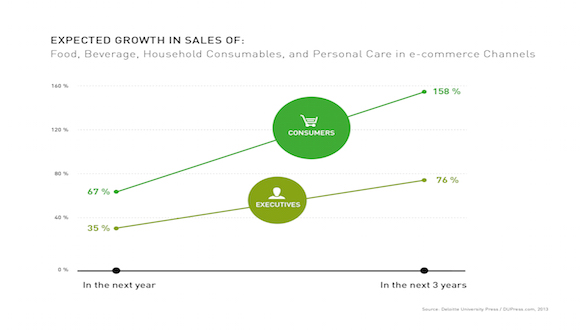
The other piece that is sort of countering this trend of the uninformed consumer that’s been discussed for many years is the fact that there’s a big expected growth in sales of food, beverages, household consumables and personal care in e-commerce channels moving into the future. According to recent research by Deloitte University Press in conjunction with Duke University in 2013, when they asked consumers and executives how much more shopping they would do in the context of food, beverage, household consumables and personal care in e-commerce channels, consumers said they would be likely to see a 67% expected growth in the next year in terms of how much they would buy via e-channels and a 158% increase over the course of the next three years. The interesting thing is that executives in these industries are way less bullish - they say that they expect to see an increase in the growth of sales in e-commerce channels of 35% in the next year which is still pretty massive and 76% in the next three years.
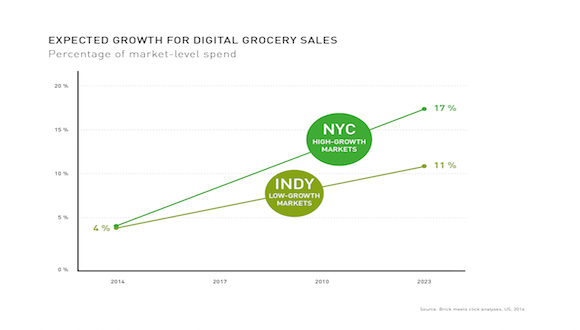
We can also compare this with the expected growth of digital grocery sale where a high growth market such as New York city according to research by Brick Meets Click analysis in the United States in 2014. The research shows that we are likely to see the percentage of market level spend go up from 2014 at a level of 4% to 11% and in high growth markets like New York, 17% of the market level spend taking place in digital grocery sales channels. In this space we also got some interesting start up activity with the likes of Instacart that is like an Uber for your shopping where you have a personal shopper who delivers food to your doorstep or even to your apartment or your house. Down to the specific occasions and quantities specified by you, it now integrates with the app Yummly where you can follow celebrity chefs who have their own recipes where essentially you can just now have the exact recipe and ingredients delivered to your doorstep. This again is a huge factor driving a new consumer behaviour for the informed consumer.
This brings me to the second trend I talked about at the event which is the idea of top down vs bottom up sourcing. Now what do we mean by this? Well, top down sourcing would be for example, the big grocery chains and the retailers saying we have this amount of potatoes and this many pumpkins are available so that’s what we are going to market to you versus bottom up sourcing would be basically on demand-driven saying if the consumers tomorrow feel like they want artichokes or maybe fresh berries, then we should offer that. The interesting question here is how are businesses within the food industry going to manage that sort of top down push versus a bottom up approach to sourcing. So what are some examples of start ups in this space? In terms of on demand-food services we have the likes of Seamless, Munchery, Instacart as I mentioned earlier in the blog, SpoonRocket, Drizly, DoorDash and Fresh Direct. And when it comes to dining and drinks we have the likes of Dash, Groupon and OpenTable. And at the moment we are seeing a big increase in the venture capital investment in the on-demand economy and these are just some examples of that activity. Many of the food startups represent this novel approach of bottom up sourcing or bottom up demand for new types of services.
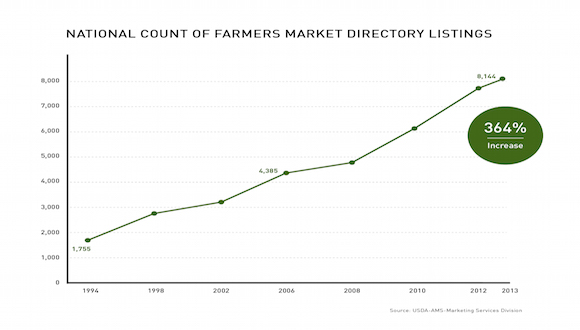
The other focus here is on the hyperlocal. The national count of Farmers Market Directory listings in the United States has gone up from 1755 in 1994 to in 2013 be at the level of 8144, a 364% increase in the last 20 years and of course nowadays there is no longer just from farm to table food that we are interested or getting to know our farmers at the local farmers market. But it’s also from farm to iphone with the likes of Where Food Comes from, verifying the source of your Rib Eye steak, by simply scanning the QR-code when you are instore and therein get access to the story and the whole supply chain that led to say Daisy The Cow sacrificing herself to provide the food that ends up on your plate. Speaking of the subject of provenance and the increasing consumer interest in where food comes from, there is a great video from the TV-series Portlandia where two of the proponents sit down and ask where is the chicken from or is the chicken local?
And with this focus on sustainability, local sourcing and local demand we are seeing that retailers are needing to adapt and that’s why perhaps startups like FarmedHere which is a vertical farm that are taking disused space in an urban Chicago and growing the likes of local organic basil, local baby arugula, local salad greens and local petit sallad greens like thai basil, fresh mint, opal basil, lemon basil and basil. They are able to grow that locally but also sell it hyper-locally to restaurants in the area and I believe as we said at Produce Marketing Association's summit in conjunction with Cornell University that this has the ability to over time also battle the fruits and vegetables food waste in the supply chain in North America. By making sure that people look at the fact that 52% of all vegetables and fruits that are grown in the field become waste and only 48% turn into actual food. Through the production handling and storage packaging, distribution and retailing consumer, parts of the value chain we at each stage lose a lot of food to waste. Now it goes without saying if you have local producers within a city like Chicago supplying the local restaurants nearby with fresh vegetables and fruits that less is gonna be wasted because the supply chain is much shorter geographically. One of the examples I spoke about here is the initiative by Intermarché– they are repackaging the idea of ugly fruits or les fruits et les légumes moches. Check it out!
This brings me to the final point of the presentation which is this idea of human vs robots and the fact that the farmer of the future is not neccessarily going to be old McDonald but might be an old iRobot. This is nothing new, already by 1931, the Country Gentleman Magazine imagined what the future farmer would look like in 2031 and in that magazine they painted a picture of a farmer in his suit and tie sitting in front of what looks like a touch screen and with capabilities of driving his fleet of drones and machines out in the field. Not too dissimilar to John Deere's imagination of the future of farming or Farm Site, which they launched a couple of years ago with a farmer operating his entire farm from a touch screen in his living room. And of course we look at statistics like the sale of industrial robots in the largest international markets and the fact that already in Japan, 30% of all rice fields are being fertilized by drones. We can imagine that the role for drones and robots in agriculture and in the produce industry will grow exponentially over the next few years, pending of course regulatory concerns (again it’s forecast by the annual UAS Sales for Agriculture of Public Safety and other markets).
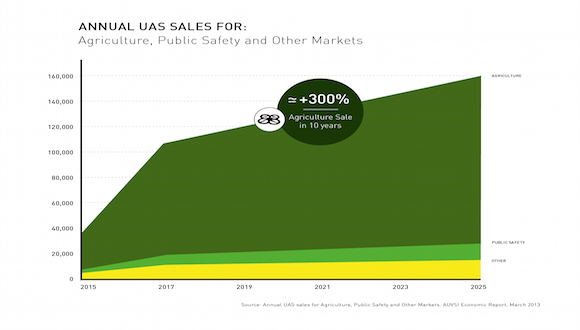
There is going to be a 300% increase in the agricultural sales in the next ten years out to 2025 because of the demand for new robotics. Now when you look at the fact that the American Trucking Association in 2010 warned the industry that by 2022 there would be a massive shortfall of 239 000 truckdrivers.
This all goes to the point that Andrew McAfee and Eric Brynjolfsson make in their book The Second Machine Age: Work, progress and prosperity in a time of brilliant technologies where they say that there is going to be a decoupling between US producivity and job growth. The two historically have always gone hand in hand when producitivity increases, jobs grow but in the last few years and in the last decade there has been a clear decoupling and Brynjolfsson and McAfee argue that this is because increasingly robots and technologies are stealing our jobs. And we have seen a precedent to this in the agricultural space before where in the 1950s the agricultural share of US employment was about 21% and today it’s hovering around the 2% mark - a 95% decrease since post world war 2 levels.
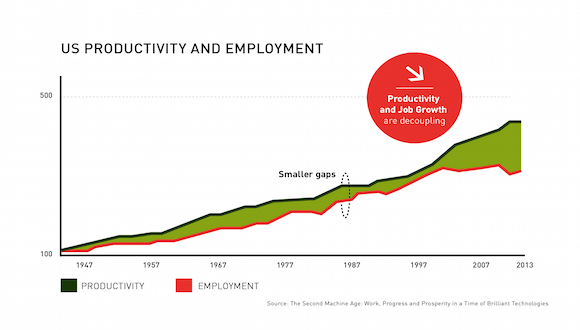
Again this is largely because humans have been replaced by robots, again if we look at things like US manufacturing jobs contra global industrial robots sales and employment according to the Bank of America and Merryl Lynch Global Investment Strategy Report together with Bloomberg in 2013 we see that we should be long robots and short human beings in this manually intensive space. So these are the three trends we spoke about at the event. The scenario planning exercise that I set up with the attendees in Dallas, Texas resulted in some really interesting discussions about the future of the produce marketing space and produce industry as a whole. I look forward to bringing you more insights into the future of produce and the future of farming and of course how provenance marketing has a huge ability to connect in a age when tradition meets technology.
Some links for further readings on this subject:
Re-thinking Grocery - Driving Consumer Centricity
Your Food Is Going To be Grown By Robots, As They Take Over The Farm
10 Innovative Food Projects Reconnecting Eaters And Producers
Food Shoppping And Digital Tech: Are We Thinking Boldly Enough?
On Smaller Farms, Including Organic Farms, Technology And Tradition Meet
Some more key stats and interesting insights:

Header Text
Lorem ipsum dolor sit amet, consectetur adipiscing elit, sed do eiusmod tempor incididunt ut labore et dolore magna aliqua. Ut enim ad minim veniam, quis nostrud exercitation ullamco laboris nisi ut aliquip ex ea commodo consequat. Duis aute irure dolor in reprehenderit in voluptate velit esse cillum dolore eu fugiat nulla pariatur.
Lorem ipsum dolor sit amet, consectetur adipiscing elit, sed do eiusmod tempor incididunt ut labore et dolore magna aliqua. Ut enim ad minim veniam, quis nostrud exercitation ullamco laboris nisi ut aliquip ex ea commodo consequat. Duis aute irure dolor in reprehenderit in voluptate velit esse cillum dolore eu fugiat nulla pariatur.
Lorem ipsum dolor sit amet, consectetur adipiscing elit, sed do eiusmod tempor incididunt ut labore et dolore magna aliqua. Ut enim ad minim veniam, quis nostrud exercitation ullamco laboris nisi ut aliquip ex ea commodo consequat. Duis aute irure dolor in reprehenderit in voluptate velit esse cillum dolore eu fugiat nulla pariatur.

Header Text
Lorem ipsum dolor sit amet, consectetur adipiscing elit, sed do eiusmod tempor incididunt ut labore et dolore magna aliqua. Ut enim ad minim veniam, quis nostrud exercitation ullamco laboris nisi ut aliquip ex ea commodo consequat. Duis aute irure dolor in reprehenderit in voluptate velit esse cillum dolore eu fugiat nulla pariatur.
Lorem ipsum dolor sit amet, consectetur adipiscing elit, sed do eiusmod tempor incididunt ut labore et dolore magna aliqua. Ut enim ad minim veniam, quis nostrud exercitation ullamco laboris nisi ut aliquip ex ea commodo consequat. Duis aute irure dolor in reprehenderit in voluptate velit esse cillum dolore eu fugiat nulla pariatur.
Lorem ipsum dolor sit amet, consectetur adipiscing elit, sed do eiusmod tempor incididunt ut labore et dolore magna aliqua. Ut enim ad minim veniam, quis nostrud exercitation ullamco laboris nisi ut aliquip ex ea commodo consequat. Duis aute irure dolor in reprehenderit in voluptate velit esse cillum dolore eu fugiat nulla pariatur.

Header Text
Lorem ipsum dolor sit amet, consectetur adipiscing elit, sed do eiusmod tempor incididunt ut labore et dolore magna aliqua. Ut enim ad minim veniam, quis nostrud exercitation ullamco laboris nisi ut aliquip ex ea commodo consequat. Duis aute irure dolor in reprehenderit in voluptate velit esse cillum dolore eu fugiat nulla pariatur.
Lorem ipsum dolor sit amet, consectetur adipiscing elit, sed do eiusmod tempor incididunt ut labore et dolore magna aliqua. Ut enim ad minim veniam, quis nostrud exercitation ullamco laboris nisi ut aliquip ex ea commodo consequat. Duis aute irure dolor in reprehenderit in voluptate velit esse cillum dolore eu fugiat nulla pariatur.
Lorem ipsum dolor sit amet, consectetur adipiscing elit, sed do eiusmod tempor incididunt ut labore et dolore magna aliqua. Ut enim ad minim veniam, quis nostrud exercitation ullamco laboris nisi ut aliquip ex ea commodo consequat. Duis aute irure dolor in reprehenderit in voluptate velit esse cillum dolore eu fugiat nulla pariatur.
& STAY UP TO DATE WITH FORESIGHTS AND TREND REPORTS!
WE WILL EQUIP YOU WITH THE VIDEOS AND MATERIALS YOU NEED TO SUCCESSFULLY PITCH ASN.
0 Comment